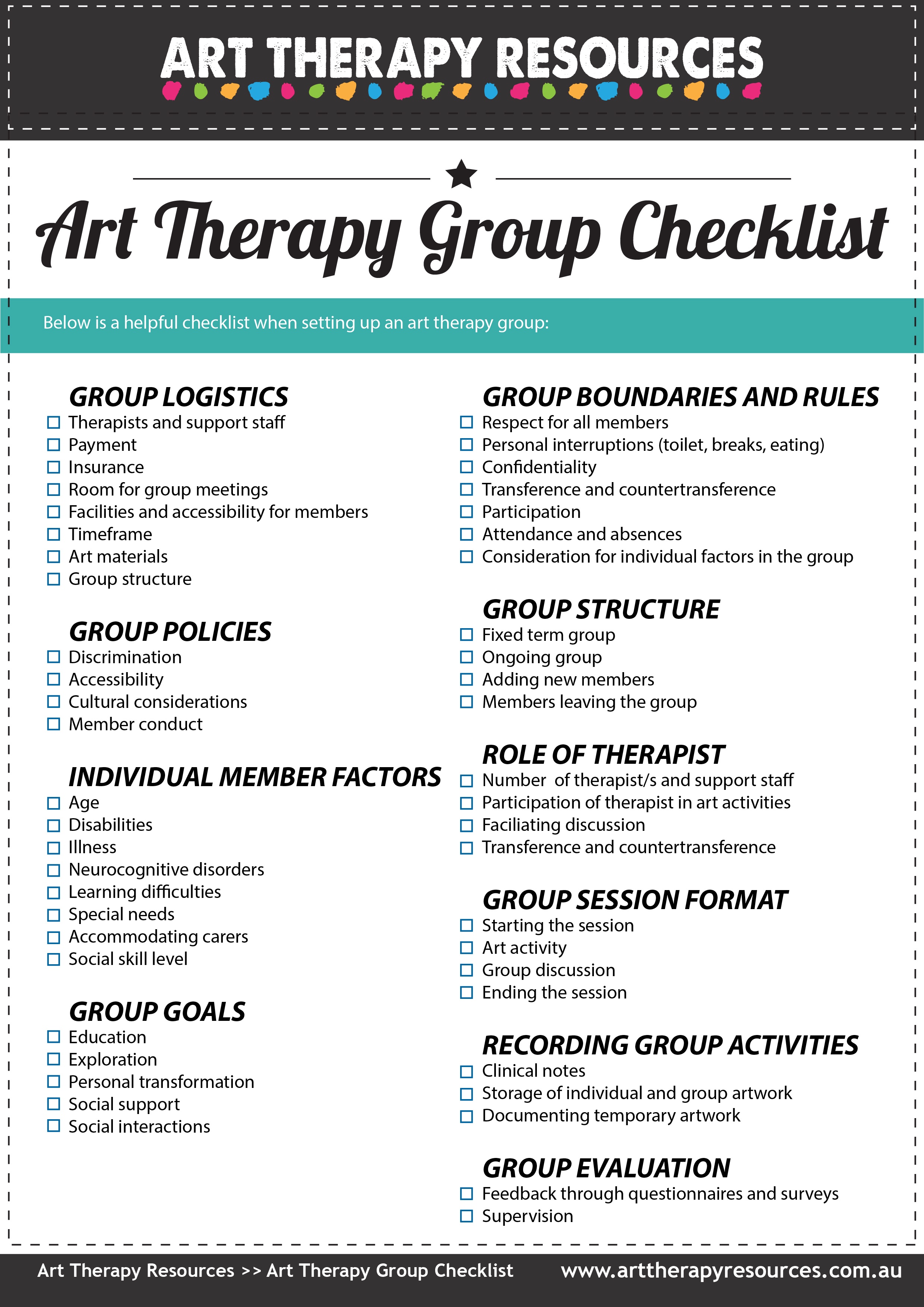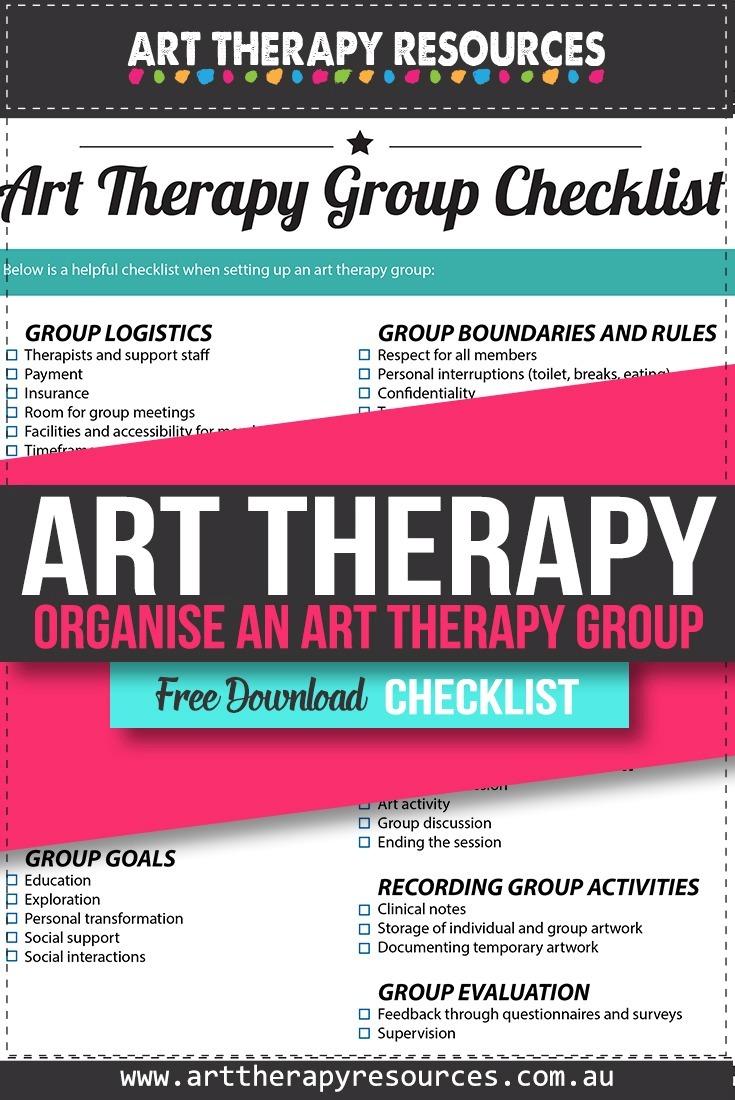THIS POST INCLUDES:
1. What is an art therapy group
2. Benefits of an art therapy group
3. Running an art therapy group
4. Examples of art therapy groups
5. Free Download – Art Therapy Group Checklist
WHAT IS AN ART THERAPY GROUP
An art therapy group is designed to facilitate the therapeutic process by using art as a method of exploration and discovery of personal experiences and emotional expression.
The construct of the group provides a different dynamic to therapy than individual sessions between a single client and therapist. Often the dynamics of the group play a part in the healing process for the individual through shared experiences and group support.
Group therapy also exists using more traditional talk therapy methods. This can sometimes be a confronting environment for individuals who have difficulty sharing their experiences in public and with strangers. However, an art therapy group can help alleviate these fears when the individual can use art activities as their ‘voice’ in sharing their experiences. This can feel less confronting and safer for the individual to begin sharing with others in the group.
To read more about art therapy groups, check out our previous blog post on group therapy:
BENEFITS OF AN ART THERAPY GROUP
An art therapy group can provide numerous benefits in place of individual therapy or group talk therapy.
Some common reasons for establishing an art therapy group are listed below:
- Facilitates social learning in a supportive environment through cooperation and communication
- Individuals with similar experiences can provide support to each other through listening and sharing strategies to help with problems
- Members can learn from the collective experience and feedback of other members
- Exercises can be developed that take advantage of the number of people in a group (eg. role-playing)
- Individuals can feel empowered by their success at developing interpersonal skills within the group
- Groups can defray concerns about focused attention on one individual. The individual can feel ‘safety in numbers’ while exploring their emotions
- Groups can demonstrate fairness, sharing, and support through the rules of engagement
- Group work can provide an overall sense of community and reduce feelings of isolation
- Groups can help reduce the cost of seeking therapy if individuals are unable to afford individual therapy
- Increases an individuals exposure to diversity within a group of people and can help expand beliefs and assumptions about other people
- The presence of other members can inspire and motivate members to make personal transformations
Although there are many benefits to running an art therapy group, there are also disadvantages and factors to consider including:
- Ensuring confidentiality among a larger group of people
- Groups require more attention and resources to source
- An individual member may not get enough assistance to help them benefit from the therapeutic activities
- Group dynamics may become stressful between individual members
- Some members may feel intimidated by other members of the group
All of these issues can be addressed by establishing group rules and paying attention to how individuals and the group as a whole are functioning.
RUNNING AN ART THERAPY GROUP
If you are considering running an art therapy group, below is a checklist of areas to consider when setting up your group:
- Group facilitator – who are the art therapists and assistants involved in the group. Define the roles of each facilitator.
- Group schedule – location and time. Consider transport limitations for clients.
- Group demographics – participant demographics and size of the group.
- Group goals – generalised and/or specific goals. Focus of the mental health issue, and/or social issues.
- Group rules – define boundaries for confidentiality, respect for group members, and general social rules.
- Psychoeducation – educate group members about transference, projection, and potential to establish exclusionary subgroups.
- Group session structure – general guidelines for introduction, artwork, discussion, and closing.
- Group effectiveness – recording and evaluation of the group progress compared to the goals that were originally established.
- Contingencies – establish contingencies for the practicalities of running the group such as change of location and time.
- Conflict – establish protocols for dealing with conflict between group members.
TYPES OF ART THERAPY GROUPS
Some types of art therapy groups include:
-
OPEN STUDIO – each individual work on their own projects at their own pace. The setting is informal and the art therapist has discussions with each individual separately without a group discussion.
-
ISSUES OR THEME BASED – the group meets to address specific issues or experiences such as grief, anger or divorce. This therapy is usually conducted in a shorter time frame to address a specific issue.
-
GROUP ANALYSIS – this style is an extension of the open studio style. The approach to art making is open, however, group discussions occur.
-
INTERACTIVE GROUP – in this group the dynamics of the group is an integral part of the therapy process. This style is a mix of theme based and group analysis. The interaction of the group forms part of the discussion process.
-
SOCIAL ACTION GROUPS – this style is an extension of the theme based group style and focuses on a social issue that the group may be facing. Examples include asylum seekers, natural disaster victims, and religious groups.
ART THERAPY GROUP SET UP CHECKLIST
Below is a helpful checklist when setting up an art therapy group:
- Group logistics including therapists, payment, insurance, room, accessibility, facilities, timeframe, art materials, and size of the group
- Group policies regarding discrimination, accessibility, cultural considerations, and member conduct
- Individual member factors – age, mental and physical disabilities, and illness, neurocognitive disorders, learning difficulties, special needs etc
- Establish the group’s goals
- Establish group boundaries and rules about behaviour, transference, and countertransference
- Closed group with fixed members OR open group with ongoing addition of new members
- Role of the therapist when interacting with the group and the activities
- Group session format including start, art activities, discussion and ending the session
- Recording group activities
- Evaluation group dynamics and achievements
ISSUES TO CONSIDER IN A GROUP
Some of the issues you need to consider in a group setting are the diversity of the group demographics. Demographic diversity refers to race, culture, gender, age, disability, health, and religion. From a social psychology point of view, individuals will connect with group members who best resemble their own demographic. This is evidenced by women’s groups, elderly groups, and religious groups that identify with like-minded individuals.
As individuals, we can benefit from exposure to other people with different backgrounds. When individuals with demographic differences gather together with similarities in circumstances, a bond can form that will help facilitate the therapeutic alliance between group members. This has occurred where communities have experienced a natural disaster such as floods.
Conversely, depending on the circumstances, bringing together a cross-sectional group can also be detrimental to the group cohesiveness and functionality. In the case of sexual abuse victims, it is best to define groups based on age appropriateness given the level of discussion around traumatic events.
While group therapy can serve as a space to broaden understanding and awareness, it is not the place to experiment with group dynamics and inquisitively observe the interactions of group members. As a therapist, you should use your discretion when forming groups and referring clients to attend group therapy.
EXAMPLES OF ART THERAPY GROUPS
Some of the most common art therapy groups that are established are based around the logistics and psychological issues or life experiences that present as a common theme within the group.
Examples of common art therapy groups are:
- Aged care groups – focusing on maintaining memory, concentration, and achievement
- Health based groups – examples include breast cancer groups
- Acute psychological focused – includes groups with acute psychological issues such as schizophrenia, anorexia, psychosis, depression.
- Institutional groups – school, prisons, hospitals, mental health facilities
- Issues based groups – dealing with bereavement, relationships
- Social issues based groups – examples include groups for refugees and collective groups experiencing a similar social issues
- Children – based on general age, learning difficulties and common disorders
- General public – created for fostering community interaction and education about art therapy
- Gender based groups – groups that focus on issues specific to gender
- Profession based groups – examples include groups for art therapists or other mental health professionals
FREE DOWNLOAD: Art Therapy Group Checklist
SIGN UP below to download the FREE Art Therapy Group Checklist.

BUILD YOUR ART THERAPY REFERENCE MATERIALS:
Pin this image to your Pinterest board.

SHARE KNOWLEDGE & PASS IT ON:
If you’ve enjoyed this post, please share it on Facebook, Twitter, Pinterest. Thank you!
